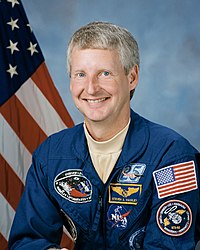Steven Alan Hawley
| Steven Hawley | |
|---|---|

|
|
| Country: | United States |
| Organization: | NASA |
| selected on | January 16, 1978 ( 8th NASA Group ) |
| Calls: | 5 space flights |
| Start of the first space flight: |
August 30, 1984 |
| Landing of the last space flight: |
July 28, 1999 |
| Time in space: | 32d 2h 42min |
| retired on | February 27, 2008 |
| Space flights | |
Steven Alan Hawley (born December 12, 1951 in Ottawa , State of Kansas , USA ) is a former American astronaut .
Hawley received a bachelor's degree in physics and astronomy from the University of Kansas in 1973 and a PhD in astronomy and astrophysics from the University of California, Santa Cruz in 1977 . During and after his studies, he conducted research at various observatories.
Astronaut activity
In January 1978, Hawley was selected by NASA as an astronaut candidate. Before the first space shuttle mission ( STS-1 ) he worked as a simulator pilot for software testing at the Shuttle Avionics Integration Laboratory (SAIL). For STS-2 , STS-3 and STS-4 , he was a member of the support teams at the Kennedy Space Center . From 1984 to 1985 he was technical assistant to the director of flight crew operations. From 1987 to 1990 he was deputy head of the astronauts office. In June 1990 he became a director at NASA's Ames Research Center . In August 1992, he returned to the Johnson Space Center as assistant director for flight crew operations. From February 1996 he trained for the STS-82 mission and then resumed his work as Deputy Director for Flight Crew Operations. From October 2001 to November 2002 he was Director of Flight Crew Operations. He was then Associate Director for Astromaterials Research and Exploration Science at the Space and Life Sciences Directorate of the Johnson Space Center.
STS-41-D
On his first space flight, Hawley was a mission specialist on the maiden flight of the space shuttle Discovery on August 30, 1984. Except for the commander, he and the other four crew members were all space newbies. During the six-day mission, the three satellites SBS-D, SYNCOM IV-2 (also known as LEASAT 2) and Telstar 3-C were deployed . In addition, the OAST-1 solar cell experiment and the CFES-III experiment to study crystal growth were carried out. In addition, recordings were made with an IMAX camera that was carried along . During the mission, dangerous ice sheets had to be removed from the orbiter using the shuttle's robot arm.
STS-61-C
Hawley took off on January 12, 1986 on the Columbia space shuttle for the STS-61-C mission . The main objective of the mission was to put the SATCOM KU-1 communications satellite into orbit. In addition, numerous smaller astrophysical and material science experiments were carried out.
STS-61-J
This Atlantis mission STS-61-J , which was canceled due to the Challenger disaster, should have deployed the Hubble Space Telescope in October 1986. The crew were John Watts Young (would have been his 7th start), Charles Frank Bolden , Kathryn Dwyer Sullivan , Bruce McCandless and Steven Hawley. This mission later became STS-31.
STS-31
Hawley's third flight began on April 24, 1990. STS-31's primary mission was to deploy the Hubble Space Telescope . In addition, images of the earth were made with an IMAX camera. The Discovery landed on April 29th after five days.
STS-82
Hawley flew with the space shuttle Discovery on February 11, 1997 on the second maintenance mission for the Hubble Space Telescope (HST). Hawley operated the robotic arm on a total of five space exits (EVAs) during which the telescope was repaired. In addition to a tape recorder, which was replaced by a core memory, the HST received the NICMOS infrared camera and the STIS spectroscope . Two spectrographs have been expanded for this purpose.
STS-93
On July 23, 1999, Hawley flew into space aboard the Columbia space shuttle as part of the STS-93 mission . The Chandra X-ray telescope was deployed during the five-day mission . Experiments in the fields of biology, astronomy, atmospheric research and space technology were then carried out on board the space shuttle.
According to NASA
In February 2008, Hawley left NASA and became a faculty member at the University of Kansas .
Private
Hawley was married to astronaut Sally Kristen Ride from 1982 to 1987 . The marriage was childless. He is a second married to former NASA PR officer Eileen M. Keegan.
See also
Web links
- Short biography of Steven Alan Hawley at spacefacts.de
- NASA biography of Steven Alan Hawley (PDF)
- Biography of Steven Hawley in the Encyclopedia Astronautica (English)
| personal data | |
|---|---|
| SURNAME | Hawley, Steven Alan |
| BRIEF DESCRIPTION | American astronaut |
| DATE OF BIRTH | December 12, 1951 |
| PLACE OF BIRTH | Ottawa , Kansas |